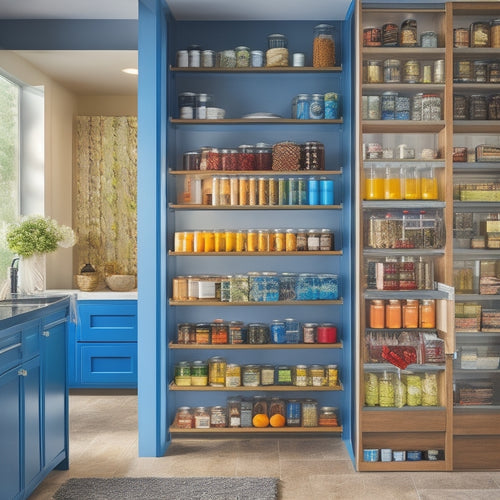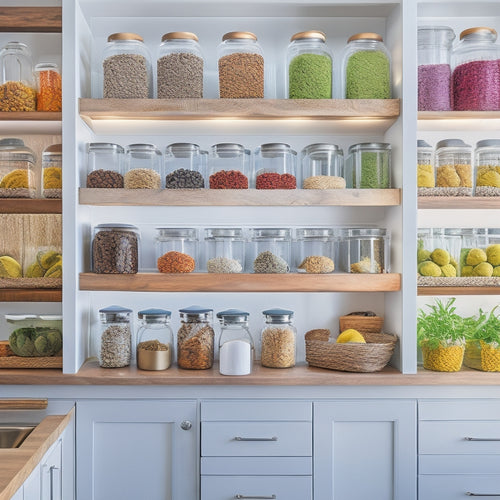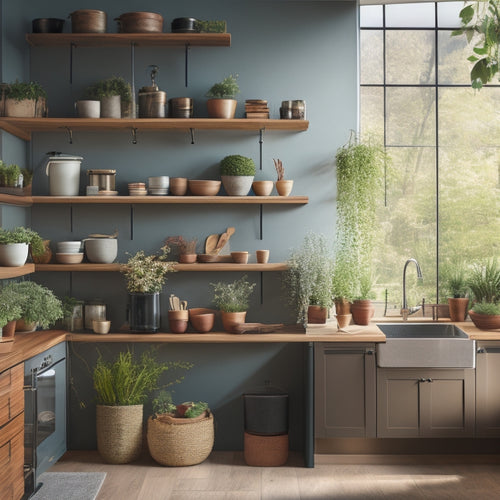
5 Kitchen Storage Hacks for Healthy Eating
Share
You're on the path to creating a healthy eating haven! Start by maximizing your pantry space with strategic organizational systems and categorizing items into groups. Utilize vertical storage options like shelves and hooks to free up counter space. Designate zones for healthy foods, and store them by expiration date to make sure you're using the freshest ingredients. Optimize your countertop real estate by allocating space efficiently and keeping frequently used items within reach. By implementing these 5 kitchen storage hacks, you'll be well on your way to a healthy eating space that fuels your wellness goals - and that's just the beginning of your kitchen transformation.
Key Takeaways
• Implement a categorization system to group similar pantry items, freeing up space for healthy staples and making meal planning easier.
• Utilize vertical storage options like shelves, hooks, and pegboards to maximize kitchen space and keep countertops clutter-free.
• Designate specific zones for healthy food groups, using clear containers and a labeling system to optimize storage and meal planning.
• Store food items by expiration date, using organization bins and a labeling system to ensure efficient stock rotation and reduce food waste.
• Allocate countertop space efficiently by designating zones for frequently used items, spices, and fruits, and investing in vertical storage solutions.
Maximize Your Pantry Space
By implementing a few strategic organizational systems, you can reveal the full potential of your pantry, freeing up valuable space to store healthy staples and making meal prep a breeze. A well-organized pantry is essential for healthy eating, as it allows you to easily access the ingredients you need to prepare nutritious meals.
Start by categorizing your pantry items into groups, such as grains, proteins, and snacks. Then, use drawer dividers to separate these groups within your pantry drawers. This will prevent clutter from building up and make it easier to find what you need when you need it.
Next, consider using shelf risers to maximize your pantry's vertical space. These risers allow you to stack items like cans, jars, and boxes, making the most of your pantry's shelves. By doing so, you'll be able to store more items in a smaller space, keeping your pantry organized and clutter-free.
With these simple systems in place, you'll be able to focus on what really matters – preparing healthy, delicious meals for yourself and others.
Utilize Vertical Storage Options
Take advantage of your kitchen's often-wasted vertical space by installing shelves, hooks, or a pegboard on walls, doors, or the back of cabinets to store items like cookbooks, spices, or utensils. This will help keep your countertops clutter-free and make it easier to find what you need when cooking healthy meals.
You can also use hanging baskets or wall shelves to store fresh fruits, vegetables, or herbs, keeping them visible and accessible. Consider installing over the door racks or tiered organizers to maximize storage in tight spaces, such as near the refrigerator or oven.
These vertical storage options will help you make the most of your kitchen's space, keeping your cooking area organized and efficient. By utilizing your kitchen's vertical space, you'll be able to focus on preparing healthy meals for yourself and others, rather than wasting time searching for misplaced ingredients or cleaning up clutter.
Designate Zones for Healthy Foods
Now that you've optimized your kitchen's vertical space, it's time to get intentional about the types of foods you're storing and preparing by designating zones for healthy foods. This means creating specific areas for fruits, vegetables, whole grains, lean proteins, and healthy snacks.
By doing so, you'll make healthy eating easier and more convenient. Start by assigning a zone for each food group and use clear containers to store items within each zone. This will help you quickly identify what's inside and make meal planning a breeze.
Implement a labeling system to categorize each zone and container, making it easy to find what you need when you need it. For instance, label a container 'Fresh Fruits' or 'Quinoa and Brown Rice.'
Store Food by Expiration Date
Organize your kitchen storage by grouping similar foods together, then arranging them in order of their expiration dates, making sure you consume the oldest items first. This system helps reduce food waste and saves you money. Implement a labeling system to identify the contents and expiration dates of each item, making meal prep a breeze.
| Category | Item | Expiration Date |
|---|---|---|
| Dairy | Milk | 02/15/2023 |
| Canned Goods | Black Beans | 06/30/2024 |
| Meat | Chicken Breast | 03/22/2023 |
Use organization bins to store items like grains, snacks, and spices, and practice rotating stock to make certain the oldest items are front and center. This visual system helps you quickly identify what you need to use up and plan your meals accordingly. By storing food by expiration date, you'll avoid expired or spoiled food, reduce waste, and maintain a healthy and organized kitchen.
Optimize Your Countertop Real Estate
Maximize your kitchen's productivity by allocating countertop space efficiently, ensuring frequently used items are within easy reach while less-used items are relegated to secondary storage areas. This strategic approach will streamline your meal prep and cooking process.
Designate a specific zone for spice organization, keeping your most-used spices in a convenient and accessible spot. This will save you time and reduce clutter.
Next, consider investing in a fruit basket or a decorative container to store fresh fruits and vegetables. This won't only add a touch of elegance to your kitchen but also encourage healthy snacking.
When it comes to appliance storage, think vertically. Install a pegboard or a utensil organizer on a wall or the side of a cabinet to hang frequently used items like pots, pans, and utensils. This will free up valuable countertop space and keep your kitchen organized.
Frequently Asked Questions
How Do I Prevent Pests From Getting Into Stored Food?
To guarantee food safety, you prevent pests by sealing containers tightly, storing them off the floor, and keeping your pantry clean and dry, protecting your food from unwanted critters and maintaining a pest-free environment.
Can I Store Cooked Meals in Glass Containers?
You can store cooked meals in glass containers, perfect for freezing leftovers and reheating options like microwaving or oven-warming, ensuring safe and convenient meal prep while maintaining food quality and freshness.
Are Mason Jars a Good Option for Storing Dry Goods?
You're considering mason jars for storing dry goods, but don't forget to explore vacuum sealing and alternative containers for best freshness. Effective labeling and organizing strategies will also help you maintain a clutter-free pantry.
How Often Should I Clean and Sanitize My Kitchen Storage?
You should clean and sanitize your kitchen storage every 1-2 weeks, or more often if you notice spills or contamination, to maintain proper frequency and guarantee a hygienic environment for your stored food and cooking essentials.
Can I Use Baskets to Store Food in Humid Climates?
As you imagine a tropical paradise, you wonder if baskets can store food safely in humid climates. While they're aesthetically pleasing, opt for air-tight containers instead, ensuring pantry organization and freshness in moisture-prone environments.
Related Posts
-

Sliding Pantry Organizers With Tiered Racks
Sliding pantry organizers with tiered racks optimize your pantry space and enhance accessibility. These organizers cr...
-

Innovative Lazy Susan Storage Solutions
Innovative Lazy Susan storage solutions are a revolutionary advancement for any space, especially in kitchens. They m...
-

Easy-To-Install Kitchen Wall-Mounted Racks
Installing easy-to-use kitchen wall-mounted racks is a smart way to maximize your space. These racks help keep your c...


